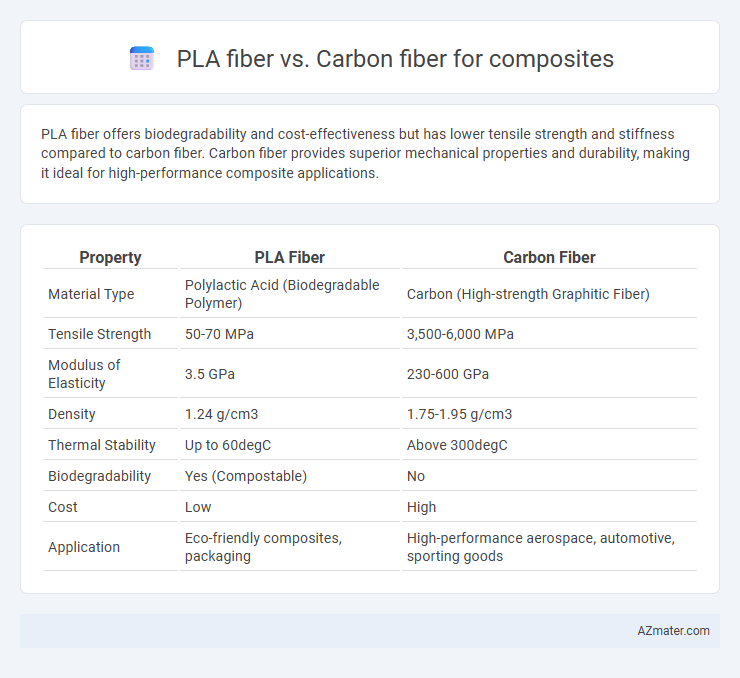PLA fiber offers biodegradability and cost-effectiveness but has lower tensile strength and stiffness compared to carbon fiber. Carbon fiber provides superior mechanical properties and durability, making it ideal for high-performance composite applications.
Table of Comparison
| Property | PLA Fiber | Carbon Fiber |
|---|---|---|
| Material Type | Polylactic Acid (Biodegradable Polymer) | Carbon (High-strength Graphitic Fiber) |
| Tensile Strength | 50-70 MPa | 3,500-6,000 MPa |
| Modulus of Elasticity | 3.5 GPa | 230-600 GPa |
| Density | 1.24 g/cm3 | 1.75-1.95 g/cm3 |
| Thermal Stability | Up to 60degC | Above 300degC |
| Biodegradability | Yes (Compostable) | No |
| Cost | Low | High |
| Application | Eco-friendly composites, packaging | High-performance aerospace, automotive, sporting goods |
Introduction to PLA Fiber and Carbon Fiber
PLA fiber, derived from renewable resources like cornstarch, offers a biodegradable and eco-friendly alternative for composite materials with moderate strength and stiffness. Carbon fiber, composed of thin strands of carbon atoms bonded in a crystalline formation, provides exceptional tensile strength, high stiffness, and low weight, making it ideal for high-performance composite applications. Both fibers serve distinct roles in composites, where PLA fiber emphasizes sustainability and biodegradability, while carbon fiber focuses on superior mechanical properties and durability.
Material Properties Comparison
PLA fiber offers biodegradability, low density (approximately 1.25 g/cm3), and moderate tensile strength around 50-70 MPa, making it suitable for eco-friendly composite applications. Carbon fiber exhibits significantly higher tensile strength (3,500 MPa to 6,000 MPa) and stiffness (modulus of 230-600 GPa), with a density of about 1.6 g/cm3, providing superior mechanical performance in high-strength composites. While PLA fiber enhances sustainability and recyclability, carbon fiber remains the preferred choice for applications demanding exceptional strength-to-weight ratios and durability.
Strength and Durability Analysis
PLA fiber composites exhibit moderate tensile strength and biodegradability, making them suitable for lightweight, eco-friendly applications but with limited durability under prolonged stress or high temperatures. Carbon fiber composites outperform PLA in strength, offering exceptional tensile strength, stiffness, and fatigue resistance, making them ideal for high-performance structural applications requiring long-term durability. Material selection depends on application-specific strength demands, environmental exposure, and lifecycle sustainability considerations.
Weight and Density Differences
PLA fiber exhibits a density of approximately 1.25 g/cm3, significantly lower than carbon fiber's typical density of around 1.75 g/cm3, making PLA fibers lighter in weight for composite applications. Despite its lower density, PLA fiber offers moderate mechanical strength compared to carbon fiber, which delivers superior strength-to-weight ratios essential for high-performance composites. The weight advantage of PLA fibers suits applications requiring reduced mass and cost, whereas carbon fiber remains preferred for demands of maximum strength and stiffness.
Environmental Impact and Sustainability
PLA fiber, derived from renewable resources like corn starch, offers significant biodegradability and a lower carbon footprint compared to synthetic carbon fiber, which relies on energy-intensive production from non-renewable petroleum. Carbon fiber composites excel in durability and strength but present challenges in recycling and contribute to long-term environmental pollution due to their resistance to natural degradation. Choosing PLA fiber enhances sustainability in composites by promoting circular economy principles and reducing reliance on fossil fuels, though performance trade-offs must be considered based on application requirements.
Cost and Manufacturing Considerations
PLA fiber offers a more cost-effective alternative to carbon fiber, with raw material prices significantly lower due to its bio-based origin and simpler production process. Manufacturing PLA fiber composites requires less energy-intensive equipment and lower processing temperatures, resulting in reduced operational expenses and shorter cycle times. Carbon fiber composites demand high-temperature curing and specialized handling to ensure optimal strength, driving up manufacturing complexity and total cost.
Applications in Composite Materials
PLA fiber offers biodegradability and eco-friendly characteristics suitable for lightweight, low-strength composite applications such as packaging, disposable products, and automotive interior panels. Carbon fiber provides superior tensile strength, stiffness, and thermal resistance, making it ideal for high-performance composite materials used in aerospace, automotive structural components, and sports equipment. The selection between PLA fiber and carbon fiber composites depends on the required mechanical properties, environmental impact, and cost-effectiveness for specific industrial applications.
Performance in Real-World Conditions
PLA fiber composites exhibit lower tensile strength and impact resistance compared to carbon fiber composites, making them less suitable for high-stress applications. Carbon fiber composites demonstrate superior fatigue resistance, thermal stability, and stiffness, which enhances durability and performance in harsh environmental and load conditions. Real-world testing confirms carbon fiber's advantage in aerospace and automotive industries where long-term reliability and weight reduction are critical.
Future Trends and Innovations
PLA fiber composites are gaining traction due to their biodegradability and renewable sourcing, positioning them as a sustainable alternative in lightweight applications. Carbon fiber continues to dominate high-performance sectors with innovations focusing on enhanced strength-to-weight ratios and cost reduction through advanced manufacturing techniques like automated fiber placement. Future trends indicate hybrid composites combining PLA fiber's eco-friendliness with carbon fiber's superior mechanical properties to meet evolving environmental regulations and performance demands.
Conclusion: Choosing the Right Fiber for Composites
PLA fiber offers a sustainable, biodegradable option for composites, ideal for applications where environmental impact is a priority and mechanical demands are moderate. Carbon fiber provides exceptional strength-to-weight ratio and stiffness, making it the preferred choice for high-performance aerospace, automotive, and sporting goods. Selecting the right fiber depends on balancing factors such as mechanical requirements, cost constraints, and environmental considerations.

Infographic: PLA fiber vs Carbon fiber for Composite
 azmater.com
azmater.com